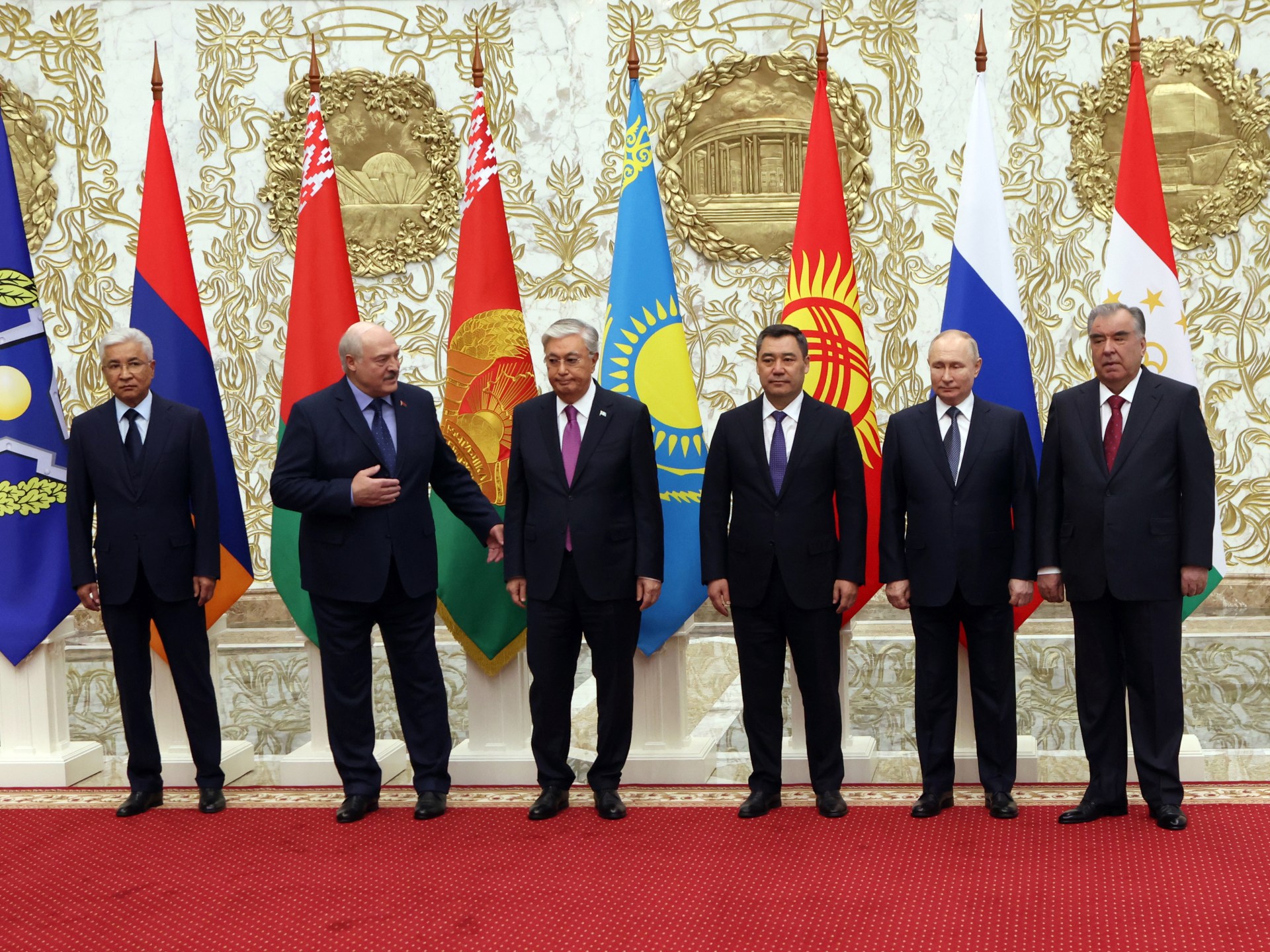A group of CSTO leaders during their most recent meeting in November 2023 in Minsk, Belarus (Getty)
Moscow
- The 75th anniversary of the founding of the North Atlantic Treaty Organization (NATO) constitutes an occasion to consider the issue of other military alliances in the world, the establishment of which was an attempt to create a military balance to fill the void that formed after the collapse of the Soviet Union and the Warsaw Pact in 1991.
On May 15, 1992, the independent post-Soviet states - Russia, Armenia, Kazakhstan, Kyrgyzstan, Tajikistan and Uzbekistan - signed the Collective Security Treaty. They were followed by Azerbaijan, Georgia and Belarus - respectively - and signed the agreement in 1993.
The agreement entered into force on April 20, 1994, and was designed for a period of 5 years, subject to extension. On April 2, 1999, the presidents of Armenia, Belarus, Kazakhstan, Kyrgyzstan, Russia, and Tajikistan extended the treaty for another 5 years, but Azerbaijan, Georgia, and Uzbekistan refused to extend it.
Although the main objectives of the Collective Security Treaty Organization lie in ensuring national and collective security, deepening military-political interaction, and coordinating foreign policy positions on international and regional security issues and others, some facts revealed that the alliance that was established on the ruins of the Soviet military and security system did not It constitutes a counterweight to or a counterpart to NATO.
The organization was forced to use force only once, during the bloody protests that Kazakhstan witnessed in 2022, in which President Kassym-Jomart Tokayev asked for support, and indeed the first units arrived in Kazakhstan on January 7, and the main declared goal of the preservation unit was The organization's mission is to protect important government and military installations, and to assist government forces in achieving stability, which was ultimately achieved.
CSTO peacekeeping forces return to Kyrgyzstan after a mission in Kazakhstan (Reuters)
A crisis of confidence
Strategic affairs expert Nikolai Buzyn believes that the Collective Security Treaty Organization is a more complex and multifaceted organization, in addition to that each country within the organization has its own problems, as Russia is concerned about the actions of the United States and its allies aimed at undermining the international security structure, while in Belarus there are concerns. In light of the expansion of NATO and the escalation of tensions on its western borders.
As for Kazakhstan, Kyrgyzstan and Tajikistan, there are strong concerns regarding the effects of the situation in Afghanistan, that is, on the southern border of Central Asia, and as for Armenia, it has a direct confrontation with Azerbaijan.
Buzyn told Al Jazeera Net, “When personal interests begin to control common goals, trouble occurs.” He explains, “Throughout its history, the organization has faced an internal crisis of confidence. For example, Kyrgyzstan asked its partners for help 3 times and was rejected every time, the first in the year 1999, when armed Islamists from Afghanistan and Tajikistan invaded the country, the second in 2010 when a bloody ethnic conflict occurred between Kyrgyzstan and Uzbeks, and the last in 2021 during the violent armed conflict on the border between Kyrgyzstan and Tajikistan.”
Hence, Buzyn believes that the organization cannot be compared to NATO, whose countries have a common political orientation. The main enemies for them are clear, namely Russia and China. In anticipation of a possible confrontation, nuclear weapons have appeared in Europe, including countries bordering Russia and neighboring China.
He also believes, on the other hand, that the same does not apply to the Security Treaty countries, which instead suffer from constant concerns about the emergence of factors of loss of confidence among its members, in addition to the purely defensive nature that characterizes it, and the lack of clear definitions of opponents and enemies, as opposed to the “offensive” strategy. "For NATO.
He explains that since World War II, more than 250 military conflicts have occurred in 153 countries, and 80% of them were caused by the United States and its coalition partners, meaning that since the founding of the alliance, there has not been a single year in which it did not participate in an armed conflict on this planet.
Ukrainian touchstone
Military expert Victor Litovkin points to another problem related to the absence of a “leading state” within the alliance, in contrast to the Warsaw Pact, of which the Soviet Union was “its head and mind.” Here, according to his opinion, the Security Treaty Organization differs in this criterion from NATO, which is cohesive and has a leader ( United States) “The rest of the coalition dances to his tune.” But on the other hand, thanks to it, member states are increasing their military power.
In response to a question about what prevents the CSTO from developing in this direction, the expert explained his opinion that the interests of the state in the organization often prevail over the interests of the coalition, which has delayed and delays the development of the organization for many years.
According to his opinion, the heterogeneity of the position within the organization towards the war with Ukraine is a clear indication of this, in addition to the non-interference of the organization’s forces in the bloody conflict that occurred between Armenia and Azerbaijan previously due to the Nagorno-Karabakh file.
In contrast, the same expert points out that NATO has been able to address its problem that has worsened in recent years, related to the presence of a real enemy, not a virtual one, which is now represented by Russia.
In his speech, he is almost certain that the war in Ukraine and luring Russia into urgent steps to resolve the conflict was a plan to revive NATO as a military-political force, which means that the countries of the organization must take actual and serious steps to develop their military-industrial capabilities and revive the military-industrial complex.
Source: Al Jazeera

